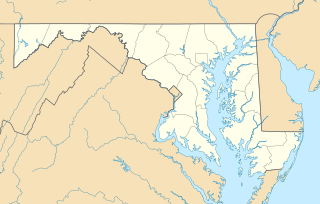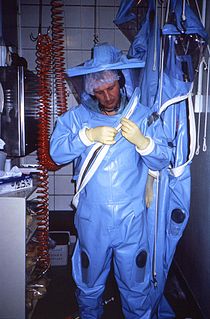Biodefense refers to measures to restore biosecurity to a group of organisms who are, or may be, subject to biological threats or infectious diseases. Biodefense is frequently discussed in the context of biowar or bioterrorism, and is generally considered a military or emergency response term.

A biosafety level is a set of biocontainment precautions required to isolate dangerous biological agents in an enclosed laboratory facility. The levels of containment range from the lowest biosafety level 1 (BSL-1) to the highest at level 4 (BSL-4). In the United States, the Centers for Disease Control and Prevention (CDC) have specified these levels. In the European Union, the same biosafety levels are defined in a directive. In Canada the four levels are known as Containment Levels. Facilities with these designations are also sometimes given as P1 through P4, as in the term "P3 laboratory".
The United States Army Medical Research Institute of Chemical Defense (USAMRICD) is a military medical research institute located at Aberdeen Proving Ground, Maryland, USA. It is the leading science and technology laboratory of the Department of Defense for the development, testing, and evaluation of medical chemical warfare countermeasures including therapies and materials to treat casualties of chemical warfare agents.

The Biocomplexity Institute of Virginia Tech is a research organization specializing in bioinformatics, computational biology, and systems biology. The Institute has more than 250 personnel, including over 50 tenured and research faculty. Research at the Institute involves collaboration in diverse disciplines such as mathematics, computer science, biology, plant pathology, biochemistry, systems biology, statistics, economics, synthetic biology and medicine. The institute develops -omic and bioinformatic tools and databases that can be applied to the study of human, animal and plant diseases as well as the discovery of new vaccine, drug and diagnostic targets.

Colonel Kanatzhan "Kanat" Alibekov – known as Kenneth "Ken" Alibek since 1992 – is a former Soviet physician, microbiologist, and biological warfare (BW) expert. He rose rapidly in the ranks of the Soviet Army to become the First Deputy Director of Biopreparat, where he oversaw a vast program of BW facilities.

The United States Army Medical Research Institute of Infectious Diseases is the U.S Army's main institution and facility for defensive research into countermeasures against biological warfare. It is located on Fort Detrick, Maryland and is a subordinate lab of the U.S. Army Medical Research and Materiel Command (USAMRMC), headquartered on the same installation.

Operation Whitecoat was a biodefense medical research program carried out by the United States Army at Fort Detrick, Maryland between 1954 and 1973. The program pursued medical research using volunteer enlisted personnel who were eventually nicknamed "Whitecoats". These volunteers, all conscientious objectors, including many members of the Seventh-day Adventist Church, were informed of the purpose and goals of each project before providing consent to participate in any project. The stated purpose of the research was to defend troops and civilians against biological weapons and it was believed that the Soviet Union was engaged in similar activities.

The concept of biocontainment is related to laboratory biosafety and pertains to microbiology laboratories in which the physical containment of pathogenic organisms or agents is required, usually by isolation in environmentally and biologically secure cabinets or rooms, to prevent accidental infection of workers or release into the surrounding community during scientific research. The term "biocontainment" was coined in 1985, but the concept stretches back at least to the 1940s.
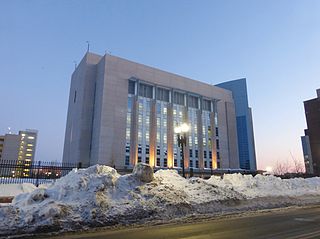
The National Emerging Infectious Diseases Laboratories, or NEIDL, is a biosciences facility of Boston University located near Boston Medical Center on Albany Street in the South End neighborhood of Boston, Massachusetts.

The One-Million-Liter Test Sphere—also known as the Test Sphere, the Horton Test Sphere, the Cloud Study Chamber, Building 527, and the “Eight Ball” —is a decommissioned biological warfare (BW) chamber and testing facility located on Fort Detrick, Maryland, USA. It was constructed and utilized by the U.S. Army Biological Warfare Laboratories as part of its BW research program from 1951 to 1969. It is the largest aerobiology chamber ever constructed and was placed on the National Register of Historic Places in 1977.

Lester Martínez López is the first Hispanic to head the Army Medical and Research Command at Fort Detrick, Maryland. His responsibilities included overseeing the Army Medical Research Institute of Infectious Disease, which develops antidotes and vaccines for diseases soldiers might face on the battlefield.
Clarence James Peters, Jr, M.D. is a physician, field virologist and former U.S. Army colonel. He is noted for his efforts in trying to stem epidemics of exotic infectious diseases such as the Ebola virus, Hanta virus and Rift Valley fever (RVF). He is an eminent authority on the virology, pathogenesis and epidemiology of hemorrhagic fever viruses.
The United States Army Medical Unit (1956–1969) — a now defunct medical research unit for biodefense — was at Fort Detrick, Maryland, USA. In contrast to the U.S. Army Biological Warfare Laboratories (1943–1969), also at Fort Detrick, the USAMU's mission was purely to develop defensive measures against bio-agents, as opposed to weapons development. The USAMU was the predecessor to today's USAMRIID.
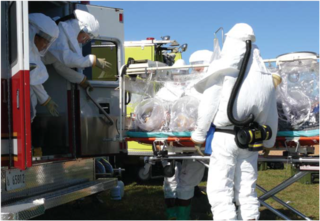
The Aeromedical Isolation Team of the US Army Medical Research Institute of Infectious Diseases (USAMRIID) at Fort Detrick, Maryland was a military rapid response team with worldwide airlift capability designed to safely evacuate and manage contagious patients under high-level (BSL-4) bio-containment conditions. Created in 1978, during its final years the AIT was one of MEDCOM’s Special Medical Augmentation Response Teams comprising a portable containment laboratory along with its transit isolators for patient transport. Contingency missions included bioterrorism scenarios as well as the extraction of scientists with exotic infections from remote sites in foreign countries. The AIT trained continuously and was often put on alert status, but only deployed for “real world” missions four times. The AIT was decommissioned in 2010 and its mission assumed by one of the US Air Force’s Critical Care Air Transport Teams (CCATTs).
The United States biological defense program—in recent years also called the National Biodefense Strategy—began as a small defensive effort that parallels the country's offensive biological weapons development and production program, active since 1943. Organizationally, the medical defense research effort was pursued first (1956-1969) by the U.S. Army Medical Unit (USAMU) and later, after publicly known discontinuation of the offensive program, by the U.S. Army Medical Research Institute of Infectious Diseases (USAMRIID). Both of these units were located at Fort Detrick, Maryland, where the U.S. Army Biological Warfare Laboratories were headquartered. The current mission is multi-agency, not exclusively military, and is purely to develop defensive measures against bio-agents, as opposed to the former bio-weapons development program.
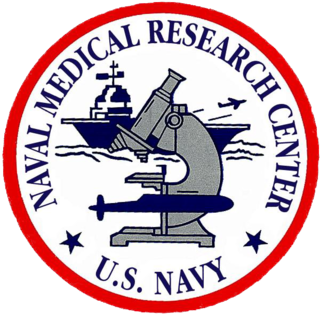
The Naval Medical Research Center (NMRC) is an agency that performs basic and applied biomedical research to meet the needs of the United States Navy and United States Marine Corps. Its areas of focus include study of infectious diseases, biodefense, military medicine, battlefield medicine, and bone marrow research. NMRC is under the United States Department of the Navy's Bureau of Medicine and Surgery.
Peter B. Jahrling is chief of the Emerging Viral Pathogens Section of the National Institute of Allergy and Infectious Diseases.
